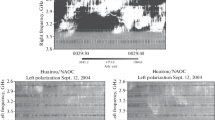Abstract
Type III bursts often have brightness temperatures at the fundamental greater than 109K. If the fundamental emission is due to scattering of Langmuir waves into transverse waves by thermal ions, this implies that induced scattering dominates over spontaneous scattering, which in turn requires that the energy density in Langmuir waves be greater than some minimum value, e.g. W l > 3 × 10-10 erg cm-3 for bursts at f p = 100 MHz. Such Langmuir waves become isotropic on a time-scale shorter than the rise-time of type III bursts, e.g. < l s at f p = 100 MHz. Consequently, their coalescence, leading to emission at the second harmonic, proceeds. The above inequalities would imply a brightness temperature at the second harmonic in excess of 109K at f = 200 MHz.
The predicted values of the brightness temperatures tT1 and tT2 (at the fundamental and second harmonic respectively) can be expressed in terms of an optical depth τ. After τ is eliminated a functional relation between tT1 , tT2 and the plasma frequency, f p , remains. The form of this relation is not dependent on a quantitative theory of how the Langmuir waves are generated by the stream of electrons. Consequently, comparison with observed quantities should provide further insight into the detailed properties of the emission processes.
Similar content being viewed by others
References
Kaplan, S. A. and Tsytovich, V. N.: 1969, Usp. Fiz. Nauk 97, 77; Soviet Phys.-Usp. 12, 42.
Leblanc, Y.: 1973, Astrophys. Letters 14, 41.
Melrose, D. B.: 1970, Australian J. Phys. 23, 871.
Melrose, D. B.: 1973, ‘The Mechanism Responsible for “Shadow” Type III Bursts. I: Absorption due to Langmuir Turbulence’, Australian J. Phys. (in press).
Smith, D. F.: 1970, Adv. Astron. Astrophys. 7, 147.
Tsytovich, V. N.: 1966, Usp. Fiz. Nauk 90, 435; 1967, Soviet Phys. - Usp. 9, 805.
Tsytovich, V. N.: 1970, Nonlinear Effects in Plasma, Plenum Press, New York.
Tsytovich, V. N.: 1972, An Introduction to the Theory of Plasma Turbulence, Pergamon Press, Oxford.
Zhelezniakov, V. V. and Zaitsev, V. V.: 1970, Astron. Zh. 47, 60; Soviet Astron. AJ 14, 47.
Author information
Authors and Affiliations
Rights and permissions
About this article
Cite this article
Melrose, D.B. A relationship between the brightness temperatures for type III bursts. Sol Phys 35, 441–450 (1974). https://doi.org/10.1007/BF00151967
Received:
Issue Date:
DOI: https://doi.org/10.1007/BF00151967




